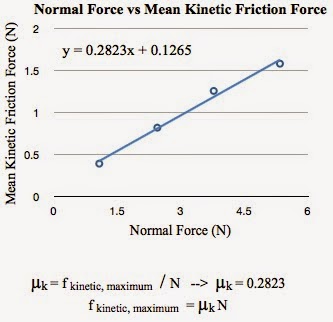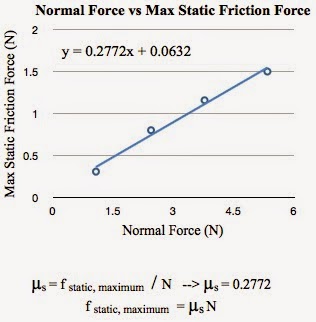Important Concepts
Part 1: In this part we found µs of a wooden blocks on a flat surface
µs: The coefficient of static friction
fs: This is static friction - when the force of friction is greater than the
applied force, also this force is needed to first move an object
fk: This is kinetic friction - the applied force is less to keep the object sliding as it
breaks free from static friction.
µk: The coefficient of kinetic friction
ex: It's harder to get a heavy object to move at first. but once it's sliding across the floor it seems easier as long as it keeps moving
PurposePart 2:In this part of the lab, we used a force sensor to read the maximum and minimum static friction force of the blocks
Part 3: We had to find µs of an object just before it starts to slide down an incline
Part 4: We found µk when an object is sliding down an incline
Part 5: We had to predict the acceleration and compare it with the measured acceleration of a two mass system
Procedure + Equipment
Part 1 - Static Friction (Cup + Water)What we used:
- wooden blocks
- pulley
- styrofoam cup
- water + water dropper
- weights
- In this part of the lab, we weighed one block by itself, then two blocks together, until we weighed 4 blocks together
- Then we took one wooden block and tied it to the pulley system
- On the other end of the pulley system we tied the styrofoam cup
- We added water into the cup, and with the water dropper, we carefully added enough water until the block started to move
- We weighed the mass of the cup and water
- We repeated steps 3 and 4 until 4 blocks were at one end
What we used:
- wooden blocks
- force sensor
- logger pro
- We first connected the force sensor to a weight and then calibrated by checking to see if logger pro was reading correctly
- We then connected the force sensor to the wooden block with string and zeroed it when it was on the table.
- Then we pulled the block across the table at a constant speed, and collected the data
- Step 4 was repeated with an extra block stacked on top until four blocks were on one side.
What we used:
- ramp
- wooden block
- angle reader
- to measure the angle of the ramp
- We set up the ramp at a small incline and placed the wooden block at the top
- The incline was increased until the wooden block started to slide
- The angle of the ramp was recorded
What we used:
- ramp
- wooden block
- angle reader
- we measure the angle of the ramp
- motion senor + logger pro
- to measure the acceleration of the block
- We set up the ramp at a new incline such that the block would accelerate
- The motion sensor was placed at the top of the ramp
- The lock was let go, and with logger pro we measured the acceleration
What we used:
- ramp
- pulley
- wooden block + hanging mass
- angle reader
- we measure the angle of the ramp
- motion senor + logger pro
- to measure the acceleration of the block
- We set up the ramp at a new incline such that we could predict the acceleration by using the µk we found in part 4
- The motion sensor went at the the bottom of the ramp
- We measured the angle, and the mass of the wooden block and the hanging mass
- The wooden block was tied to the pulley system and a hanging mass was on the other end
- First we predicted the acceleration and then measured the acceleration with logger pro and compared those two.
Data
Part 1
 |
| This is the data we collected that helped in finding what we had to graph |
Part 2
 |
| This is the data we collected with the force sensor. The force sensor was able to give us the average kinetic friction force for the wooden blocks. |
 |
| This is the data that we graphed to help us get kinetic friction |
Part 3
θ = 18º
Part 4
θ = 26º
Part 5
m1 = 0.134 kg
m2 = 0.128 kg
θ = ?
Calculations + Analysis
Part 1
Part 2
Part 3
In this part of the lab, we had to solve for µs of the block on an inclined plane. We set up of the FBD and set up our equations and solved for µs, which was µs = tan(θ). We know the angle of the ramp and we found that the µs came out to be: 0.325
So, the coefficient of static friction for the block is 0.325. It's less than our µk because that is the force needed to get the block to slide.
Part 4
In this part of the lab, the µk was solved for. We set up the FBD and set up our equations and solved for µk. The µk = gsin(θ) - a / gcos(θ), so our µk = 0.296
So, the coefficient for kinetic friction for the block is 0.296. It's less than our µs because it's already moving
Part 5
We had to test out to see that if with our calculated µk from part 4, we could calculate the acceleration of the block when it was on a two mass pulley system. Sadly, the angle for the incline wasn't measured, but we calculated what acceleration would be in terms of m1, m2, µk, and g.
We were also unable to measure the acceleration of the block, but seeing, so we have nothing to go off and compare to.
 |
| Similar to part 1, except with a constant acceleration applied to the block, we looked for the kinetic friction of the block. We found that the µs = 0.2823. |
In this part of the lab, we had to solve for µs of the block on an inclined plane. We set up of the FBD and set up our equations and solved for µs, which was µs = tan(θ). We know the angle of the ramp and we found that the µs came out to be: 0.325
So, the coefficient of static friction for the block is 0.325. It's less than our µk because that is the force needed to get the block to slide.
Part 4
In this part of the lab, the µk was solved for. We set up the FBD and set up our equations and solved for µk. The µk = gsin(θ) - a / gcos(θ), so our µk = 0.296
So, the coefficient for kinetic friction for the block is 0.296. It's less than our µs because it's already moving
Part 5
We had to test out to see that if with our calculated µk from part 4, we could calculate the acceleration of the block when it was on a two mass pulley system. Sadly, the angle for the incline wasn't measured, but we calculated what acceleration would be in terms of m1, m2, µk, and g.
We were also unable to measure the acceleration of the block, but seeing, so we have nothing to go off and compare to.
Summary
In this lab, we took a closer look at static and kinetic friction. This helped us better understand the two frictions and what their differences where. We were able to find and solve the coefficients of static and kinetic friction in two ways. Solving it by graphing our normal force vs our static/kinetic friction to get a slope that gave us the coefficients. We also solved for the coefficients using Newton's Law and the model of friction.
In part 3 and part 4, we found the coefficient of static friction for the block is
0.325 and the coefficient for kinetic friction for the block is 0.296. We found that the µs was larger than the µk, and that is due to the force needed to move the object is greater than when the object is already in motion.








No comments:
Post a Comment